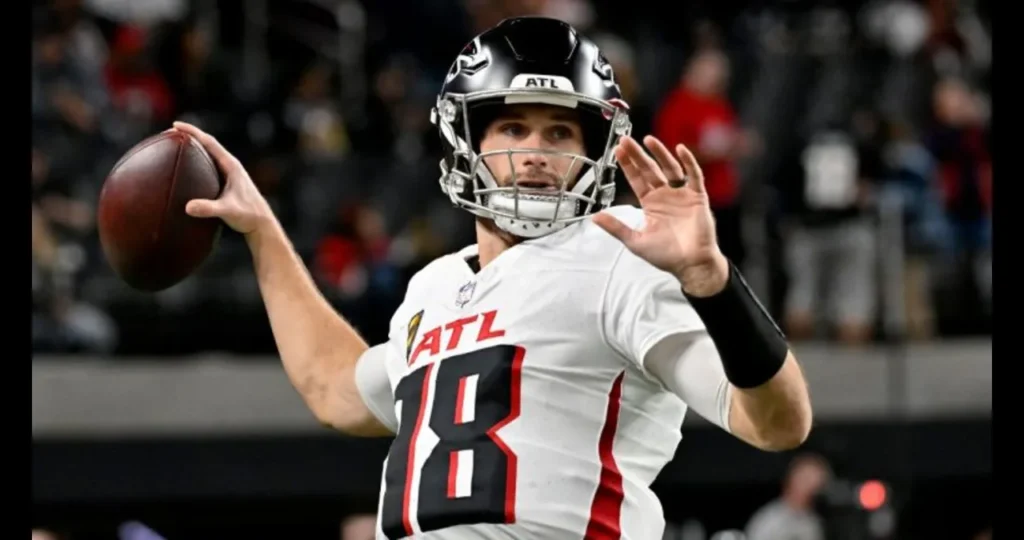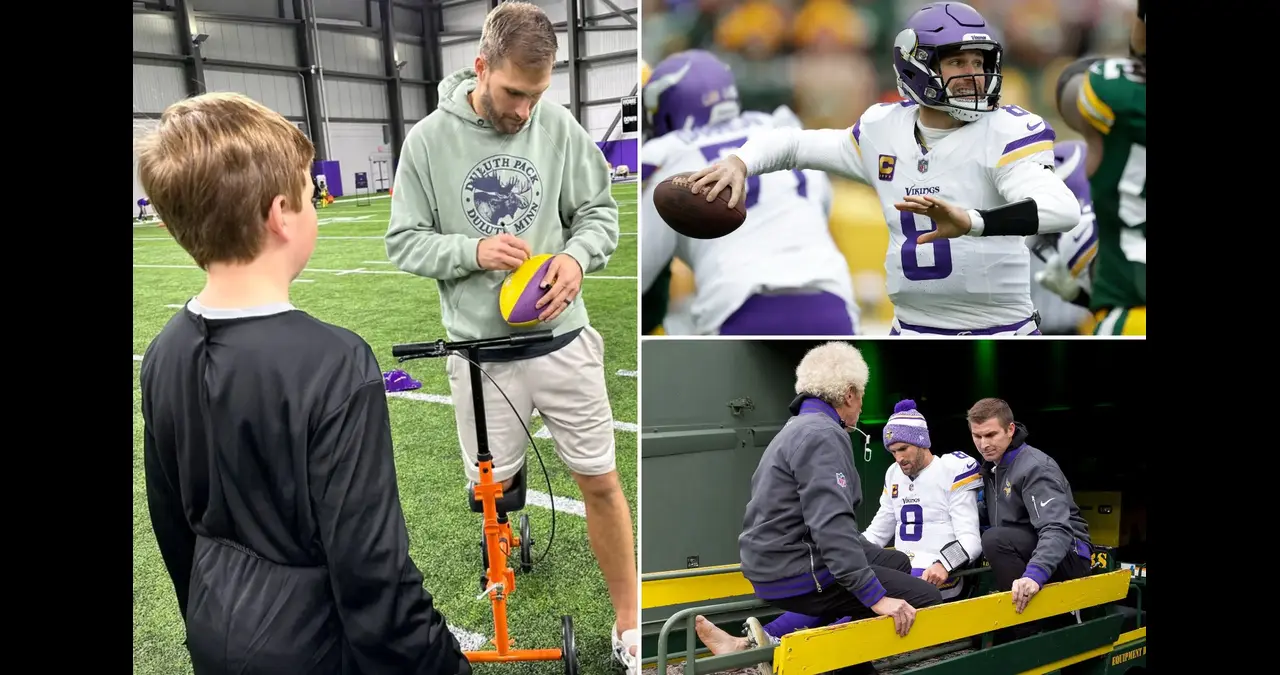Kirk Cousins Injury When the topic of Kirk Cousins’ injury comes up, it demands more than surface coverage. This article peels back every layer of how injuries have shaped Cousins’s career physically, mentally, and professionally. From his Achilles tear to subsequent shoulder, elbow, and ankle issues, this breakdown gives readers a comprehensive, expert-level understanding, all while keeping the tone conversational. Let’s get started.
Quick Bio Table
| Category | Details |
| Name | Kirk Daniel Cousins |
| Born | August 19, 1988, in Barrington, Illinois |
| Current | Team Atlanta Falcons |
| Position | Quarterback |
| College | Michigan State Spartans |
| NFL | Draft 2012, Round four, Pick 102 |
| Pro | Bowls Four (2016, 2019, 2021, 2022) |
| Known | Injuries Achilles tear (2023), shoulder & elbow pain (2024), ankle discomfort |
| Contract | Four‑year deal with Falcons, signed in 2024 |
Kirk Cousins injury Achilles Rupture and Road to Return
Cousin’s first major injury surfaced in Week eight of the twenty‑twenty‑three season while he was still with Minnesota. A ruptured Achilles brought his momentum to a sudden halt. At that moment, he was on a hot streak throwing yardage at a historic pace and propelling his team toward the playoffs. Yet within minutes, that Achilles injury ended his season and left everyone wondering how he’d come back from such a devastating physical setback
Rehab wasn’t a one‑step process. It was a multi‑stage rebuilding of strength, balance, proprioception, and footwork. In interviews after signing with Atlanta, Kirk described how his rehab shaped his offseason routines: daily Achilles‑specific therapy, layering modalities to reinforce his calf and tendon, and balancing that with throwing programs, weight training, and mobility work. That rehab reshaped his entire offseason, and likely changed his mechanics to reduce risk.
Shoulder and Elbow The Arm Injury Saga
Jumping into the twenty‑twenty‑four season, Cousins was expected to build on the recovery momentum. Instead, he faced persistent issues in his right shoulder and elbow. In week ten against the Saints, a violent hit jarred his throwing arm impacting not only his shoulder but also twisting the elbow in ways that lingered long after
On Netflix’s “Quarterback,” Cousins candidly recounts that he felt immediate shooting pain in his elbow and throbbing deep in his shoulder on that same play Despite never missing a game, performance waned dramatically after that. In the next stretch, he posted eight interceptions and only one touchdown over four games. The team lost its early‑season rhythm, sliding from a strong start to a disappointing finish.
Ankle Impacts and Ongoing Mobility
Beyond the arm wear and tear, Cousins spent the previous season (after the Achilles tear) nursing ankle discomfort. He admitted that even after the major rehab, his ankle never felt quite right a nagging concern that affected his legs‑driven throwing base.
That ankle uncertainty translated to a less stable platform in the pocket. Combine that with a compromised lower body, and Cousins was trying to compensate with his arm straining to produce despite mechanical limitations. In interviews at Falcons’ minicamp, he shared that he realized just how much that ankle had been holding him back.
Why did Cousins stay in Play Through Pain?
One might wonder why Cousins didn’t take a break. Sitting out seemed logical, right? But as he discussed on the show, there were larger stakes. He feared losing his starting role. Dropping out for even a few weeks could give rookie Michael Penix Jr. the chance to step up and stay. To Cousins, that risk felt too high. He was channeling lessons from past players about “not letting the backup see the field”
That decision shows the mental grind behind the kneel-downs. He donned the armor every Sunday, hoping to will himself through. But the grade on film was unforgiving interceptions piled up, accuracy slipped, and his timing fractured. In many ways, his desire to protect his job may have extended his window in the lineup, but it also cost him trust and momentum in his play.
Falcons Organization Awareness & Reaction
Here’s where organizational dynamics come in. After that hit in Week ten, Cousins was noted once on Week eleven’s injury report cleared to limited participation with right shoulder and elbow tags. That peek did nothing to stop the spiral.
Interestingly, Falcons GM Terry Fontenot and HC Raheem Morris later stated they had no clue about the severity. They claimed they only saw that one Kirk Cousins Injury report listing and assumed all was well. The disconnect speaks volumes about communication gaps either between player and team or in the structures that track health.

Contract & Career Ramifications
Cousins signed a massive four‑year deal with the Falcons in twenty‑twenty‑four. But the money came with expectations. If he sat out or underperformed, the contract would be risky for Atlanta. When the rookie took over in late fourteen, Cousins knew salary cap dynamics would come into play as soon as the team hit a rough patch.
By season’s end, he was benched traded out of the QB1 spot. He admitted both to being hurt and to feeling misled when the Falcons used a top‑ten pick on a quarterback after he’d signed. That duo of physical decline and strategic misalignment has shaken his trajectory in the league.
Recovery Status & Outlook
So where does he stand now? Heading into twenty‑twenty‑five, Cousins looked healthier in minicamp. He confirmed improved ankle function and said shoulder and elbow were fully healed He’s back at full speed in pre‑season workouts, and coaches report he has regained trust in his arm. The hope: that the big‑picture stability he once showed can return.
Yet, the context remains unsteady. He’s now the quarterback two in Atlanta. To climb back up, he’ll need to prove he’s not only physically ready, but also mentally primed ready to support or push the starter.
How Injuries Shape Performance – Expert’s Breakdown
In my years covering athlete rehab and performance, I’ve seen this pattern: once a QB suffers a leg injury, everything shifts. The kinetic chain becomes disrupted. If the ankle or Achilles isn’t firing properly, the arm has to work harder adding extra torque and strain to the shoulder and elbow. Over time, that cumulative stress can erode timing and rip free throws into danger territory.
Cousin’s string of injuries reads like a classic case study. The Achilles tear started the sag. Mobility slowed. The arm began overcompensating. The shoulder and elbow were next in line. It became a domino effect, leading to hesitation, accuracy dips, and the interception surge. This isn’t just unlucky it’s textbook sports biomechanics in action.
FAQ – Frequently Asked Questions
Q. Is Kirk Cousins’ injury history career‑ending?
No. While serious especially the Achilles tear none of his injuries were career-ending. His return to form in the twenty‑twenty‑five minicamp showed professional rehab and strong dedication. With modern medical care, athletes routinely recover from Achilles and shoulder issues and return to elite play.
Q. Did he ever miss games due to injury?
Surprisingly, no. He played every game in twenty‑twenty‑four despite clearly playing injured at times. His first missed game in years came only with the Achilles tear in twenty‑twenty‑three.
Q. Who knows about the arm issues?
Cousins says he told trainers and teammates. But the front office claims they didn’t realize it went beyond that single injury report. It suggests a breakdown in communication, whether by design or accident.
Q. Can he regain starting QB status?
Possibly, yes. If he stays healthy and delivers effective preseason play, he could push for a leading role either in Atlanta or elsewhere. But he must prove consistency, trust in his mechanics, and leadership to earn that spot.
Q. How might his contract affect injury recovery?
Large guaranteed money can take pressure off an athlete to rush back but it can also amplify scrutiny. Teams analyze performance‑per‑dollar. So while he might rehab with care, his performance now matters more than ever. A fully healthy Cousins can show he’s still worth every cent.
Final Thoughts
Kirk Cousins’ injury isn’t just a headline it’s an ongoing narrative of physical grit, mental perseverance, and organizational study. His Achilles rupture, followed by lingering arm and ankle issues, paints a picture of a veteran QB committed to pushing boundaries. Yet, the fallout highlights the challenge of navigating injuries in a league that doesn’t stop for pain.
As he heads into the new season, Cousins faces the task of reconnection: reconnecting with his elite self, reconnecting communication lines within the team, and rebuilding trust in every part of his body. If he can stay healthy and sharp, there’s no reason he can’t write another chapter perhaps one built on renewal, resilience, and readiness.



